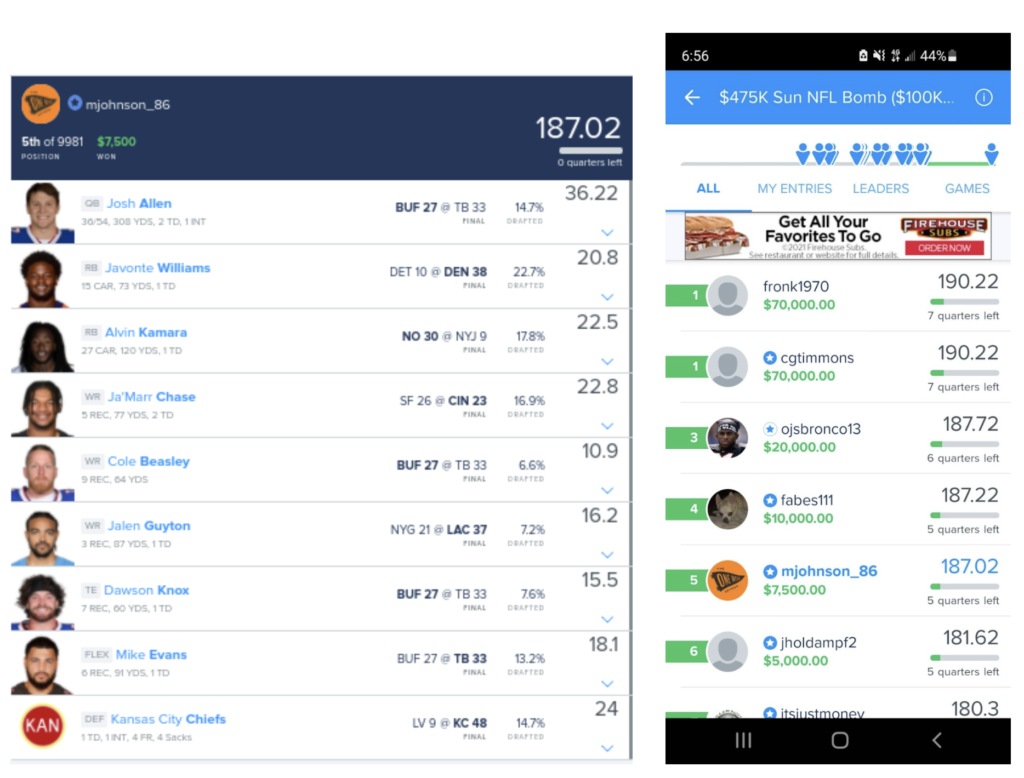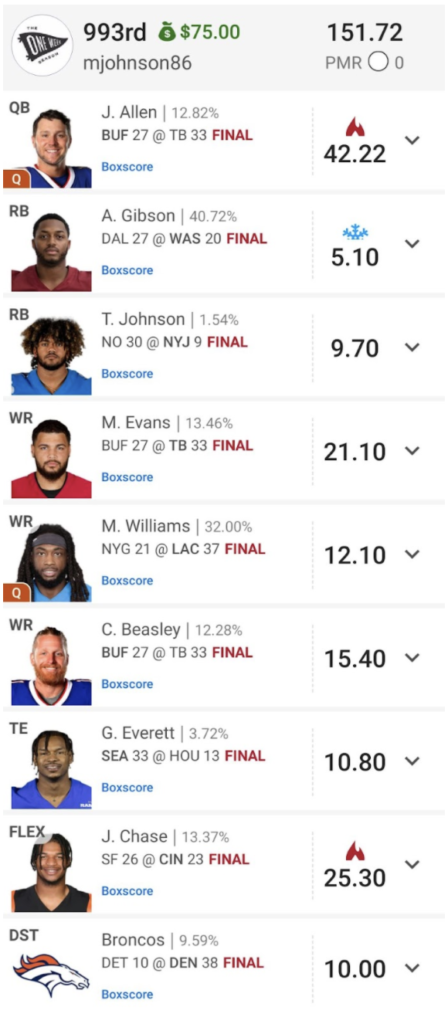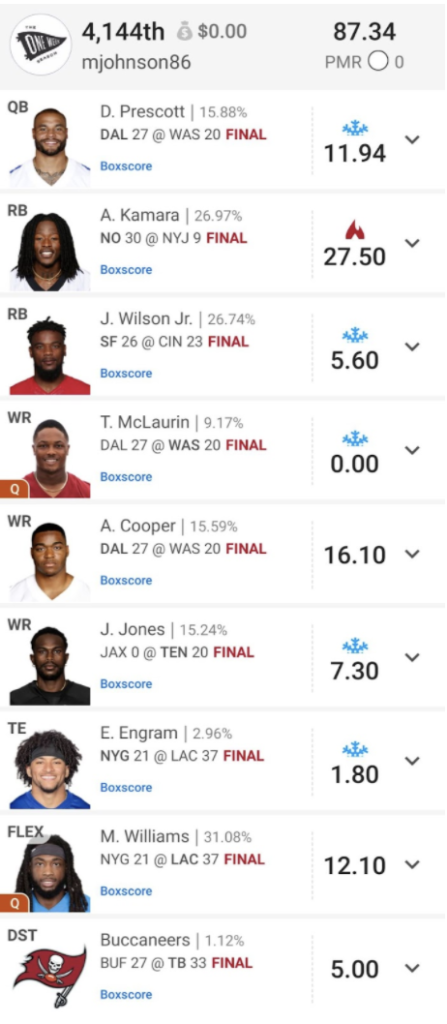Process Points. 15.21.
Lesson of the Week: Late Swap Mindset
This week was fun and profitable…..and it really, really hurt. Robbie Gould is the 6th most accurate kicker in NFL history. If Robbie Gould had made a 47-yard field goal at the end of regulation, I would have won the $55 Sunday NFL Bomb on FanDuel for $100k. Instead, he missed, and I took 5th place, 3.2 points behind the winner. George Kittle had 5.3 points in OT, and all four people who finished ahead of me had Kittle (I did not). Usually, after the fact, it is hard to know for sure exactly how things would have played out if things broke slightly differently because it is hard to know what any given play in a game may do to alter all the subsequent actions. However, when it is a direct, binary outcome like this where if he makes it, the game ends, then it becomes very clear what would have been. (I also would have won if Zac Taylor had kept his foot on the gas in their opening drive of overtime and Cincinnati had scored a touchdown). Unfortunately, Gould missed, and the rest isn’t really relevant anymore. Now, onto the lineup and the strategy behind how it was made and ultimately how the final lineup came to be:

- The really interesting thing about this lineup is that this isn’t what it looked like when the games kicked off on Sunday. I had 20 entries in the tournament, and six of them were built around Allen and the Bills/Bucs game (I actually swapped off of Allen and the Bills on two of the rosters where early players failed in the lineup).
- This lineup only had Kamara and Chiefs D playing in the early window, and both were at or near the top of their positions, so as the early games were getting into the 4th quarter and I scrolled through my lineups, this one stood out for how many quarters were remaining and how many points it currently had.
- This lineup originally had Jeff Wilson, Mike Williams, and Leonard Fournette instead of Javonte Williams, Jalen Guyton, and Mike Evans.
- When I went to look at my lineups and consider swaps for the afternoon, I couldn’t help but acknowledge how uneasy I was with the Jeff Wilson play. With Deebo Samuel back, George Kittle playing great last week, Brandon Aiyuk being out of the doghouse, and the lack of trust I have in Kyle Shanahan being predictable, I just felt really skeptical about Wilson’s role and upside. I decided with where I was sitting I wanted to get up to a running back with higher TD equity and upside. From the later games, Javonte Williams was my favorite option to make a change. Another thing I really liked about Javonte was Ezekiel Elliott and Antonio Gibson were RBs priced in the same general range as him who were popular and had already finished with poor games. This meant that if Javonte had a good game, I would be gaining on similarly built rosters.
- In order to get to Javonte, I was going to have to free up some salary. I didn’t want to touch my Bills pieces, and Beasley/Knox were on the cheap end and were going to be unique, so those weren’t going to change. I also did not want to take out Ja’Marr Chase, as his price had been falling, and I felt like he had such a huge ceiling that he could be a piece that takes me to the top.
- The two spots left to find the $1,800 were Fournette and Mike Williams. While I loved both players on paper, Williams was a high volatility play (uncertain role after not practicing all week, chance of being game scripted out) for the ownership he would carry. The Chargers were likely to have success offensively, so a scenario where Williams failed, and I could win without Ekeler would almost certainly entail another Chargers WR having a good game. My options were to play Guyton and swap down from Fournette to Evans or to play Josh Palmer and stick with Fournette. I preferred Palmer to Guyton this week on DK because it sounded like he would get more short targets and volume. On FanDuel, however, I decided to go with Guyton as he has made some big plays recently, and I really liked his upside, especially since I was betting on someone taking those types of plays away from Mike Williams. Also, Evans and Fournette were pretty even plays to me, but Evans was carrying half the ownership.
- If I had done nothing, I would have taken 41st for $300. I also would have had a very difficult path to the top as many people ahead of me had Wilson and Williams.
- If I had played Palmer-Fournette instead of Guyton-Evans, I would have scored two more points and taken 3rd for $20k.
- If Robbie Gould made a kick, the Gabriel Davis TD went to Knox or Beasley, or the Bills had found a little more production at the end of regulation or in OT with Knox or Beasley….I would have won $100k.
The thing to understand from those last few bullet points is that I had no control of how things played out on the field, only the position I put myself in. Only one other person in the top 10 had Cole Beasley, only two had Guyton, and only one had Knox — and no one else had two of them together. I used late swap and the information at hand to make an informed decision and give myself paths to first. A glaring lesson from this for me was how my roster construction and approach changed from where it was before the games started to where it was once I was staring a high-potential roster in the face. The “comfortable” plays of Wilson and Williams suddenly had a lot of holes, and I (rightfully) felt like I didn’t have a shot at making it to the top if I kept them in. The week was shaping up to be relatively lower scoring, with the leading teams only around 160 points after the early games, and I knew that if I kept two players in my lineup who were 30%+ owned and they hit for ceiling games, it was likely going to drive winning scores to a level that I wasn’t going to be able to reach — that forced my mindset to shift from “what is likeliest to happen” to “what has a realistic chance to happen that would give me a path to first.” In last week’s Tuesday pod, JM talked about trying to go in the future and look back at what may seem obvious in hindsight for the week. Taking that a level further and combining it with my experience from Sunday, I think when building lineups, we need to find a way to fast forward and put ourselves in the “late swap” mindset when initially building our lineups. What are the scenarios where your lineup has a high score? Does the lineup give you multiple paths to the top? If your lineup goes off and gets you near the top, will you have enough unique players that you have a few different things that could break your way to take it down at the end? (You need to understand that at the end of any tournament, most of the rosters near the top have a lot of players in common — what will you have to “root” for at the end, knowing if it happens you are the one who benefits?) Are there popular players you think have a high chance of failure and, if so, are there players you are high on in the same price range who could differentiate you from similarly built rosters?
These are all the questions that should be in our thought process when initially building rosters. Find a way to get into a “Late Swap” mindset because that mindset finds ways to be unique without being dumb (when you are already in the hunt, you aren’t going to chase low ceiling or truly low likelihood plays). A “Late Swap” mindset is naturally fearless.
Lineup Reviews
As outlined in my +EV Primer course (you can find in the Marketplace – either by itself or in the bundle with my player pool course), one of my approaches that keeps me from getting too high or low week-to-week is playing consistent contests and approaching them from a season-long perspective and using that to evaluate my play and ROI. This season, in this article, I will be tracking my progress on a weekly basis as I play the Single Entry (SE), 3-max, and 5-max tournaments in the $20 to $150 price range on DraftKings main slate for all 18 weeks. Rather than sweating or worrying about my ROI every week and “hoping to cash,” – my goal for the season is to maximize profit relative to that long-term investment total. The results of a given week are irrelevant.
Each week I will review the best and worst of my 11 lineups from my “Roster Block” of SE/3-Max/5-Max. Below are this week’s results, and you can find more information about my process/theory for this in my Week 1 Process Points article
Best Lineup ($300k Red Zone, Single Entry, $50)

The “story” I was telling: This lineup ended up cashing despite failing miserably at the running back spots. I had Josh Allen in four of my ten lineups for my “roster block,” and in this one, it was a skinny stack with Cole Beasley and Mike Evans. Beasley was my favorite of the Buffalo WRs as he was so much cheaper than Diggs and his role fit much better than Sanders against Tampa. I preferred Evans as the bring-back due to his high variance role and the fact he was projecting for the lowest ownership and had the lowest price tag among the top Bucs skill players. I really liked Mike Williams and Antonio Gibson this week, so I jammed them in a good amount of lineups regardless of their ownership. If you feel strongly about plays, that is fine to do. You just need to find leverage and lower ownership elsewhere. Ty Johnson felt like for such a low price, the game could set up well for him to get 15+ points and offered leverage off Taysom and Kamara ownership, as well as a direct price pivot off of Jeff Wilson. Meanwhile, Everett and Chase worked together to offer various points of leverage as a good Everett game would take away from Lockett and Metcalf, who were fairly popular, and also Chase was priced so close to those receivers and lower owned which meant he was a nearly direct pivot off of them. Being able to cash in a lineup that only got four touchdowns from non-QBs and had no 100-yard rushing or receiving bonuses is a pretty rare thing.
Worst Lineup ($600k Power Sweep, 3-Max, $150):

The “story” I was telling: I was high on Dallas this week as it felt like they may end up under-owned and were in a potential smash spot for the passing game with Pollard out and Washington short-handed on defense. The worst thing I did here was underestimating my competition, as the Power Sweep is a very sharp field, and Dak’s ownership ended up far higher than projections were showing as many other people saw those same possibilities that I was seeing. Dak ended up having higher ownership than Josh Allen, which should have made Allen almost an automatic. I ate the chalk at RB with Kamara and Wilson, again working on the assumption that my core stack would be far more unique than it was. I also played Julio based on some ownership projections that, based on the talk around the industry, should have been clear that he was going to be higher owned. Williams/Engram mini-correlation was fine in theory. The best thing I did in this lineup was playing the Bucs defense since this was my only lineup that had no Bucs or Bills players. As a talented defense at home, the Bucs D smashing was the likeliest scenario of those two offenses, both failing to meet expectations.
Week 14 Results: Three of ten lineups cashed this week. Within the roster block, I made some poor decisions and mistakes with my structures and didn’t do a good enough job of giving myself realistic paths to ceiling games. I voluntarily played Jets and Giants players, sometimes even without correlation, and the results showed for it.
Week 14 Investment: $765
Week 14 Winnings: $200
Estimated Yearly Investment: $14,000
Yearly Winnings: $5,300
